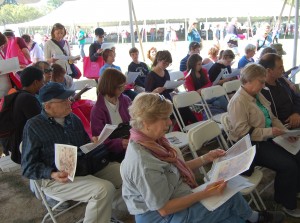This guest post is from the Library of Congress Teacher in Residence, Earnestine Sweeting.
Did you miss the 2012 Library of Congress National Book Festival? The weekend was filled with bestselling authors, book-signings, and presentations. The Library of Congress had its own pavilion featuring Library staff introducing attendees to the wonders of the Library. The Library’s K-12 education staff were there talking about the Library’s free educational resources and giving away appreciation gifts for teachers and school librarians.
Many units within the Library had the opportunity to do a presentation for attendees. Educational Outreach staff helped attendees “Discover the Power of Library of Congress Primary Sources…and Books”. I’ve been a teacher for many years but I’ve never taught in such an environment. Imagine an outdoor classroom with hundreds of kids and families strolling, life-sized story book characters roaming, and bursts of cheers booming from tents near and far – during instruction? I knew that it would be a challenge to engage the audience in deep thinking amidst the excitement.
To start, I prepared book festival-goers to draw conclusions and make inferences for a set of three primary sources. Then I asked that they keep mental notes about each item individually, but also plan to formulate a hypothesis about the relationship between the three primary sources. First, visitors were invited to analyze their own printout of a drawing by civil war sketch artist Alfred Waud, discuss their observations with a neighbor and say what they thought when they viewed the picture. “It looks like people helping the injured,” a response called out from the distance. Another response called out from an even further distance wondered, “Is this from the Civil War?”
We then looked at two additional primary sources, President Lincoln with Gen. George B. McClellan and group of officers along with a Map of the Battle of Antietam, to confirm ideas about this event. These primary sources were selected to support a picture book, Just in Time, Abraham Lincoln by award-winning author Patricia Polacco.
Picture books are often used to engage elementary students. Here are some ways teachers can incorporate primary sources associated with other books:
Students can:
- Distinguish differences between fiction and nonfiction books about the same event.
- Evaluate diverse interpretations by examining images of the same event by different artists.
- Select an image depicting one or more people. Study the image and write dialogue or “thought bubbles” to accompany the image.
- Participate in a discussion about a primary source as work of art. Use visual evidence as a prompt to write hypotheses about a time period, theme, or event
Find step-by-step instructions on how primary sources can be used to enhance books in Book Backdrops, one of the Library’s ready-to-use and downloadable professional development activities.
Tell us how you might use primary sources with books to help your students read closely and better understand literary and informational text.


